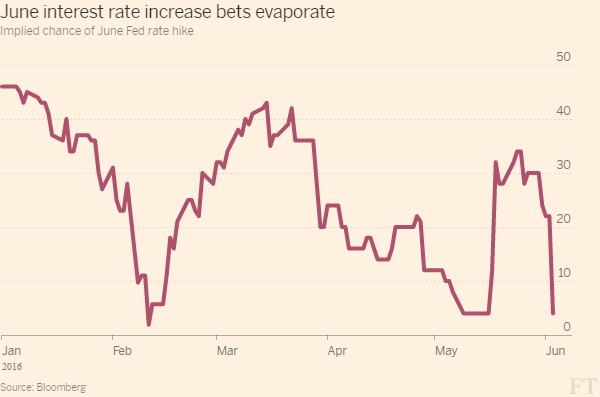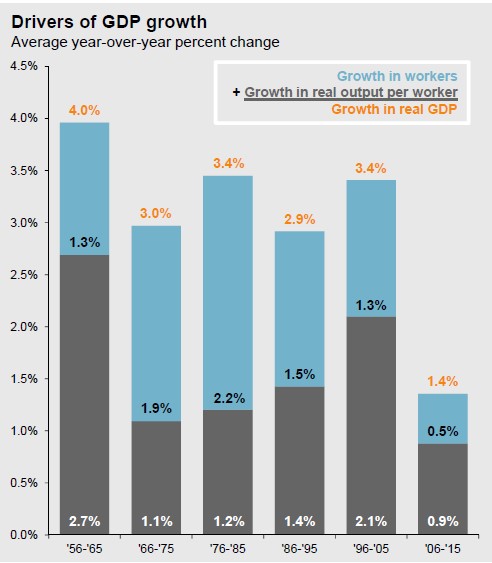
Yo-Yo Fed on Raising Interest Rates: Why?
Yo-Yo Fed on Raising Interest Rates: Why?
Janet Yellen & the FOMC met on the 14th and 15th and held off on raising interest rates in June. This comes on the heels of a terrilbe jobs report where only 38,000 jobs were created in May vs the expected 158,000. As of 14 days ago, the odds were fairly high that June would see a rate hike but came crashing down after the jobs report. As you can see in the chart below, the odds of raising have been a yo-yo for all of 2016 so it begs the question: What drives this decision?
What drives the decision to raise/lower rates?
To begin to answer that, we must first understand what the fundamental duty of the Fed is: to control money supply. How do they control the money supply? By adjusting interest rates and through buying/selling government bonds.
Buying and selling government bonds is a fairly direct concept. If they want to infuse cash into the system, they buy bonds. With more money in the system, the demand for cash decreases and interest rates fall. If they want to contract money out of the system, they sell the bonds and thus interest rates rise.
Manipulating interest rates is a little trickier because it filters through everything in our economy. If interest rates are low, the costs of living, doing business and investing are also low. This stimulates the economy because things like home and car loans are more affordable. If people can borrow more, they’ll spend more. Really low interest rates also generally weaken the dollar, which (in the short term) can be a good thing. When the dollar is weak, foreign goods are more expensive, so Americans tend to buy American-made goods. This stimulates the economy even further because high demand for American goods increases employment and wages.
Why doesn’t the Fed simply keep rates low?
The problem is that this also leads to inflation. If our demands for certain goods exceed the supply, then the product’s price will go up. When inflation increases, economic growth begins to slow. The price of the good increases, and so demand for it wanes. Less demand leads to less production, and eventually, unemployment ensues. To offset inflation, the Fed must raise interest rates.
As of late, we have seen wage inflation and CPI starting to tick upward, slightly. What could be scary about this is that we have also seen indicators that GDP is slowing which would be pause for a potential “stagflation” environment. The Fed needs to see that the growth in the economy is strong enough to sustain a rise in interest rates so they can keep inflation at their target rate of 2%.
Why do jobs reports matter so much?
Growth in our economy is made up of two components: Growth in the workforce and growth in the workforce output. Since 2006 we have only had a .5% growth in the work force and .9% growth in the output which gives us an average GDP of 2.4% – well below historic averages. So the Fed keeps a watchful eye on the jobs reports, including unemployment.
Source: BLS and BEA
Unemployment rates are low! Aren’t they?
The unemployment rate was 4.7% in May, showing that 7.4 million Americans who wanted a job couldn’t find one last month. While that is at the lowest level since 2007, it is largely due to a large amount of people dropping out of the workforce which is not included in the “headline” unemployment rate. While the headline unemployment (aka U-3 rate) is the number that is reported on most in the news, it is not the only unemployment measurement we have. The U-6 rate includes people looking for work (like the U-3), plus those stuck in part-time jobs or discouraged about finding jobs plus those who are marginally attached to the workforce is holding steady at 9.7%
So the Fed is left with a very delicate task of managing a slowing economy while at the same time seeing inflationary pressures. Janet Yellen and the FOMC must navigate extremely carefully in these waters. While we at CAISSA do not have a crystal ball on when the Fed will raise rates, we know they will. Therefore, we are keeping our fixed income in target date ETFs to minimize interest rate risk and offsetting with an overweight to domestic equities which will continue to be rewarded in a low interest rate environment.
Caissa Wealth Strategies is a fee based registered investment advisory firm, specializing in personal, dynamic wealth management. Based in Bloomington, Minnesota, Caissa financial planning professionals provide individualized strategies for every client. You can expect more from CAISSA, and in turn, you will get a fiercely loyal advocate on your side. For more news and information on wealth management solutions, visit Caissa Wealth.
